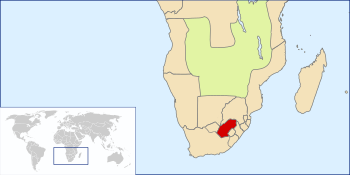Orange Free State facts for kids
Quick facts for kids
Orange Free State
Oranje-Vrijstaat
|
|||||||||
|---|---|---|---|---|---|---|---|---|---|
| 1854–1902 | |||||||||
|
Anthem: Vrystaatse Volkslied
|
|||||||||

Location of the Orange Free State c. 1890
|
|||||||||
| Capital | Bloemfontein | ||||||||
| Common languages | Dutch (official) English Sesotho Zulu |
||||||||
| Religion | Dutch Reformed African religions |
||||||||
| Government | Republic | ||||||||
| State President | |||||||||
|
• 1854 – 1855
|
J. P. Hoffman | ||||||||
|
• 1855 – 1859
|
J. N. Boshoff | ||||||||
|
• 1860 – 1863
|
M. W. Pretorius1 | ||||||||
| Legislature | Parliament | ||||||||
|
• house of representatives
|
Volksraad | ||||||||
| Historical era | 19th century | ||||||||
|
• Republic founded
|
17 February 1854 | ||||||||
| 16 December 1838 | |||||||||
|
• Start of 2nd Boer War
|
11 October 1899 | ||||||||
|
• Treaty of Vereeniging
|
31 May 1902 | ||||||||
| Area | |||||||||
| 1875 | 181,299 km2 (70,000 sq mi) | ||||||||
| Population | |||||||||
|
• 1875
|
100000 | ||||||||
| Currency | Orange Free State pound | ||||||||
|
|||||||||
|
1 Also State President of the Transvaal Republic
|
|||||||||
The Orange Free State (called Oranje-Vrijstaat in Dutch) was a country in southern Africa. It existed from 1854 to 1902. This country was mainly settled and ruled by the Afrikaners. The Afrikaners were people of Dutch, German, and French descent who had settled in South Africa.
The Orange Free State was a republic. This means it was a country where the people elected their leaders. Its capital city was Bloemfontein. The country was defeated by the British Empire and its colonies in the Second Boer War. After the war, it became known as the Orange River Colony. Later, it joined with other colonies to form the Union of South Africa.
Contents
History of the Orange Free State
How the Country Started
The Orange Free State was officially founded on February 17, 1854. Before this, the area was known as the Orange River Sovereignty. This land was under the control of the British.
However, many Afrikaners, also known as Boers, wanted to be independent. They had moved into the area during a period called the Great Trek. The British eventually decided to give up control of the region. This led to the creation of the Orange Free State as an independent republic.
Important Leaders
The Orange Free State had several leaders called State Presidents. These presidents were elected by the people. They helped guide the country through its early years and times of peace and war.
- Josias Hoffman was the first State President, serving from 1854 to 1855.
- Jan Brand was a very important president. He led the country for a long time, from 1864 to 1888. During his time, the Orange Free State grew and became more stable.
- Marthinus Theunis Steyn was the last president. He was in charge from 1896 until the country ended in 1902. He played a key role during the Second Boer War.
The Boer Wars and End of the State
The Orange Free State was involved in conflicts with the British. One major event was the Second Boer War, which started on October 11, 1899. This war was fought between the British Empire and two Boer republics: the Orange Free State and the South African Republic (also known as the Transvaal Republic).
The war was very difficult for the Boers. They fought bravely, but the British had a much larger army. The war ended on May 31, 1902, with the signing of the Treaty of Vereeniging. This treaty meant that the Orange Free State and the Transvaal Republic lost their independence.
After the war, the Orange Free State became a British colony called the Orange River Colony. Later, in 1910, it joined with other British colonies in the region to form the Union of South Africa. This marked the end of the Orange Free State as an independent country.
Life in the Orange Free State
Government and Lawmaking
The Orange Free State was a republic, meaning its government was run by elected officials. The main lawmaking body was called the Volksraad. This was like a parliament or congress. Members of the Volksraad were elected by the citizens. They made decisions about laws, taxes, and how the country was run.
Languages and Culture
The official language of the Orange Free State was Dutch. However, other languages were also spoken by different groups of people. These included English, Sesotho, and Zulu.
The main religion was the Dutch Reformed Church. This reflected the heritage of many Afrikaner settlers. However, traditional African religions were also practiced by various communities living in the state.
Money and Economy
The money used in the Orange Free State was called the Orange Free State pound. The economy was mainly based on farming, especially livestock and crops. The country also had some natural resources. In 1875, the area of the Orange Free State was about 181,299 square kilometers (about 70,000 square miles). At that time, it had a population of around 100,000 people.
Images for kids
See also
 In Spanish: Estado Libre de Orange para niños
In Spanish: Estado Libre de Orange para niños






